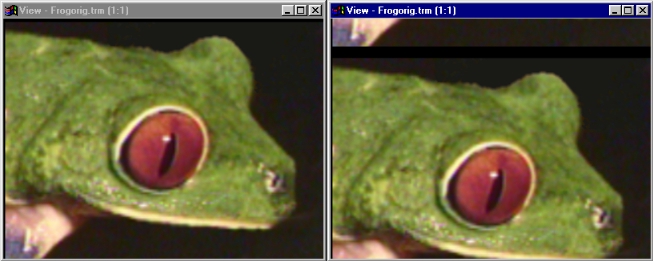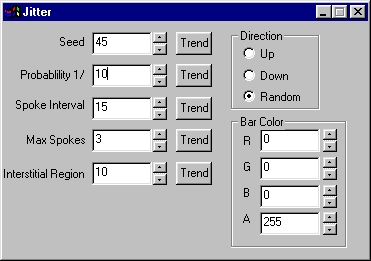| This is a child page. You can use Parent in the quick nav bar at the top or the bottom of the page to navigate directly back to the parent of this page. Some child pages are more than one level deep, and in that case will require more than one Parent click to reach the outermost document level. |
§ 16.142 - Jitter
| Quick Reference to Scripting Command |
| a=JITTER(seed,DIRECTION[0-2], probablility, spoke interval, max spokes, interstitial width, R, G, B, A) |
| Items in CAPS are 0/1 or ranges with more options than just 0/1. Ranges other than 0/1 are indicated by brackets, such as [0-2]. |

This operation is made for TimeLine animation. It adds the effect of a film projection slipping off of its track. This is a random operation, you can choose the probability that the film will slip, as well as the maximum number of spokes that it can slip.
§ 16.142.1 - Jitter Controls
§ 16.142.1.1 - Trends
Operator dialog controls that have a Trend button next to them offer animation functionality. Trend allows you to set that variable over a set of frames. Each frame of the animation can be thought of as a slice of time. The trends allow you to alter some, all, or none of the variables for a particular time slice. Variables that have multiple states can be set to any of a number of values in the trend. Variables that are either on or off can only have an on or off value in the trend. You will notice that the trend graphs have equidistantly spaced vertical lines. Each of these lines represents a frame in the animation. The number of frames can be altered using Sequence controls... in the TimeLine pull down menu. Animation lengths of 100 - 999 frames will be represented with a vertical bar being 10 frames, and animation length greater than 1000 frames will have a vertical bar for every 100 frames. Click here to view more information on Trends.
§ 16.142.1.2 - Seed
This is the seed for the random number generator. Using the same seed will provide repeatable results.
When adding a film jitter to an animation, trending the seed is advised. If the same seed is used in every frame of the animation, the same result will be produced every time. Trending the seed will give random effects.
It's not necessary to make the trendline for seed erratic or somehow random, a simple sloping line will produce a unique set of random numbers every step of the way. more on trends.
§ 16.142.1.3 - Probability
This is the probability that the film will slip. You can think of the value entered as "The film will slip every this many frames, on average." A value of 1 will insure that the frame will jitter every time. A value of 100 would mean the film only jitters every 100 frames, on average.
§ 16.142.1.4 - Spoke Interval
This is the distance (in pixels) between the "spokes" that are "moving the film." It basically acts as a way to produce the impression that the film is being jittered by a set distance.
§ 16.142.1.5 - Max Spokes
This is the maximum number of spokes that can miss when the film jitters. This number is also random but will be limited by the value you enter.
§ 16.142.1.6 - Interstitial Region
This controls the width of the region between cells (the interstitial regions).
§ 16.142.1.7 - Direction
This controls what direction the film will slip when it jitters, up or down. This also gives you the choice not to control the direction but rather to let it be determined by a random number.
§ 16.142.1.8 - Bar Color
This allows you to control the color of the interstitial region. You can control Red, Green, Blue, Alpha (all 0-255).
, Previous Page . Next Page t TOC i Index o Operators g Glossary
Copyright © 1992-2007 Black Belt Systems ALL RIGHTS RESERVED Under the Pan-American Conventions
WinImages F/x Manual Version 7, Revision 6, Level A

